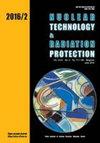Simulation analysis and experiment of magnetic pole shape influence on betatron magnetic field
IF 0.9
4区 工程技术
Q3 NUCLEAR SCIENCE & TECHNOLOGY
引用次数: 0
Abstract
Betatrons have the advantages of small size, lightweight, and simple operation. They are widely used in non-destructive testing, cargo, and vehicle safety inspection systems. Magnetic field distribution is an essential parameter of betatrons and has been investigated via experimental methods. Recently, simulations have been performed for the magnetic field distribution generated by different magnetic pole parameters. In this study, the finite element method is employed to simulate the magnetic field distribution. The effects of the different magnetic end face opening angles, pole protrusion sizes, number of central magnetic pads, and magnetic pole bottom width on the magnetic field distribution are simulated. Based on the simulation results, magnetic poles are developed, and the magnetic field distribution is measured by a gauss meter. The relative error of the measured and simulated equilibrium orbit is 2.1 %, and the relative error of the magnetic field decay index is 3.3 %. The magnetic field distribution can satisfy the essential conditions that the magnetic field at equilibrium orbit of the betatron is equal to half of the average magnetic field within equilibrium orbit and the magnetic field decay index is greater than 0 and less than 1. The results show that the finite element simulation method and established model have high reliability and effectively improve the design accuracy of magnetic poles.磁极形状对电子加速器磁场影响的仿真分析与实验
电子加速器具有体积小、重量轻、操作简单等优点。它们广泛应用于无损检测、货物和车辆安全检测系统。磁场分布是电子加速器的一个重要参数,已经通过实验方法进行了研究。近年来,对不同磁极参数产生的磁场分布进行了模拟。在本研究中,采用有限元法模拟磁场分布。模拟了不同磁端面开口角度、磁极突出尺寸、中心磁垫数和磁极底宽对磁场分布的影响。根据仿真结果,设计了磁极,并用高斯计测量了磁场分布。实测与模拟平衡轨道的相对误差为2.1%,磁场衰减指数的相对误差为3.3%。磁场分布能够满足电子加速器平衡轨道处磁场等于平衡轨道内平均磁场的一半,且磁场衰减指数大于0小于1的必要条件。结果表明,有限元仿真方法和建立的模型具有较高的可靠性,有效地提高了磁极的设计精度。
本文章由计算机程序翻译,如有差异,请以英文原文为准。
求助全文
约1分钟内获得全文
求助全文
来源期刊

Nuclear Technology & Radiation Protection
NUCLEAR SCIENCE & TECHNOLOGY-
CiteScore
2.00
自引率
41.70%
发文量
10
审稿时长
6-12 weeks
期刊介绍:
Nuclear Technology & Radiation Protection is an international scientific journal covering the wide range of disciplines involved in nuclear science and technology as well as in the field of radiation protection. The journal is open for scientific papers, short papers, review articles, and technical papers dealing with nuclear power, research reactors, accelerators, nuclear materials, waste management, radiation measurements, and environmental problems. However, basic reactor physics and design, particle and radiation transport theory, and development of numerical methods and codes will also be important aspects of the editorial policy.
 求助内容:
求助内容: 应助结果提醒方式:
应助结果提醒方式:


